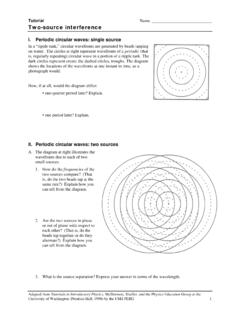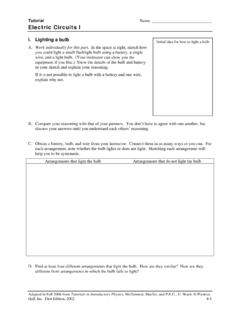Transcription of Chapter 41. One Dimensional Quantum Mechanics
1 Chapter 41. One Dimensional Quantum Mechanics Quantum effects are important in nanostructures important in nanostructures such as this tiny sign built by scientists at IBM's research laboratory by moving xenon atoms around on a metal surface. f Chapter Goal: To understand and apply the essential ideas and apply the essential ideas of Quantum Mechanics . Chapter 41. One Dimensional Quantum Mechanics Quantum Mechanics Topics: Schr dinger's Equation: The Law of Psi S h di ' E ti Th L fP i Solving the Schr dinger Equation A. A Particle in a Rigid Box: Energies and Wave Particle in a Rigid Box: Energies and Wave Functions A Particle in a Rigid Box: Interpreting the Solution The Correspondence Principle Finite Potential Wells Wave Function Shapes The Quantum Harmonic Oscillator More Quantum Models More Quantum Models Quantum Mechanical Tunneling The Schr dinger Equation Consider an atomic particle with mass m and mechanical energy E in an environment characterized by a potential energy function U(x).
2 The Schr dinger equation for the particle's wave function is Conditions the wave function must obey are 1. (x) and '(x) are continuous functions. 2. (x) = 0 if x is in a region where it is physically impossible for the particle to be. 3 (x) 0 as x + and x . 3. (x) 0 as x + and x . 4. (x) is a normalized function. Solving the Schr dinger Equation If a second order differential equation has two independent solutions . p 1((x) and . ) 2((x), then a general ) g solution of the equation can be written as where A and B are constants whose values are determined by the boundary conditions.
3 There is a more general form of the Schrodinger equation which includes time dependence and x,y,z coordinates;. We will limit discussion to 1 D solutions Must know U(x), the potential energy function the particle experiences as it moves. Objective is to solve for (x) and the total energy E=KE + U of the particle. In bound In bound state state' problems where the particle is trapped (localized in space), problems where the particle is trapped (localized in space). the energies will be found to be quantized upon solving the Schrodinger equation.
4 In unbound states' where the particle is not trapped, the particle will travel as a traveling wave with an amplitude given by (x). E, KE, and PE. E, KE, and PE. The Schr dinger Equation with Constant potential A Particle in a Rigid Box A Particle in a Rigid Box Consider a particle of mass m confined in a rigid, one . Dimensional box. The boundaries of the box are at x = 0 and x = L. 1. The particle can move freely between 0 and L at constant speed and thus with constant kinetic constant speed and thus with constant kinetic energy. 2. No matter how much kinetic energy the particle has, its turning points are at x = 0 and x = L.
5 3. The regions x < 0 and x > L are forbidden. The particle cannot leave the box cannot leave the box. A potential energy function that describes the particle in this situation is Zero point energy: even at T=0K, a confined particle will have a non zero energy of E1; it is moving energy of E1; it is moving The Correspondence Principle When wavelength becomes small compared to the size of the box (that is, when either L becomes large or when the energy of the particle becomes large), the particle must behave classically. For particle in a box: For particle in a box: Classically: The Correspondence Principle When wavelength becomes small compared to the size of the box (that is, when either L becomes large or when the energy of the particle becomes large), the particle must behave classically.
6 For particle in a box: For particle in a box: Classically: Finite Potential well: 1 Solve 1. Solve Schrodinger Schrodinger'ss equation in the equation in the three regions (we already did this!). 2. Connect' the three regions by using the following boundary conditions: 1. This will give quantized k's and E's 2. Normalize wave function Finite Potential well: Finite number of bound states, energy spacing smaller since wave function more spread out (like bigger L), wave functions extend into classically forbidden region Classically forbidden region.
7 Classically forbidden region penetration depth Finite Potential well example . Finite Potential well example Quantum well lasers Finite Potential well example . Finite Potential well example 1 D model of nucleus Qualitative wave function shapes y , y p , p2 ~1/ . Exponential decay if U>E, oscillatory if E>U positive KE, KE~p p / 2,, Amplitude~1/v~1/Sqrt[KE] (particle moving slower means more likely to be in that place). Harmonic Oscillator 1 Solve 1. Solve Schrodinger Schrodinger'ss equation in the equation in the three regions (we already did this!)
8 2. Connect' the three regions by using the following boundary conditions: 3. This will give quantized k's and E's g q 4. Normalize wave function Molecular vibrations Harmonic Oscillator Molecular vibrations E = total energy of the two interacting atoms, NOT of a single particle U = potential energy between the two atoms t The potential U(x) is shown for two atoms. There exist an equilibrium separation. At low energies, this dip looks like a parabola Harmonic oscillator parabola Harmonic oscillator solution. Allowed (total) vibrational energies: Particle in a capacitor Particle in a capacitor Covalent Bond: H2+ (single electron).
9 Covalent Bond: H2+ (single electron). Quantum Tunneling Quantum Tunneling Quantum Tunneling Quantum Tunneling . Quantum Tunneling Resonant tunneling










